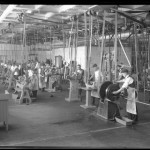Did you know that over 3,000 World War I aircraft were manufactured right here in Dayton, Ohio? The Dayton-Wright Airplane Company delivered more than 3,500 airplanes to the war front, most of which were De Havilland 4s (or DH-4s).
Our collection of Dayton-Wright Airplane Company Photographs (MS-152, click to view PDF finding aid) contains 156 large format glass plate negatives and 63 nitrate negatives depicting factory workers, interior and exterior plant views, airplane assembly, and completed airplanes from a Dayton manufacturer of World War I aircraft. These photographs have been digitized and are available online in CORE Scholar, Wright State University’s campus online repository.
The following is just a small sampling of the more than 200 photographs from this collection, which can all be viewed online in CORE Scholar. Click on an image to enlarge it, read a description, and to find a link to that image in CORE Scholar.
- MS-152, Photo #20
- MS-152, Photo #129
- MS-152, Photo #152
- MS-152, Photo #162
- MS-152, Photo #176
- MS-152, Photo #183
- MS-152, Photo #187
- MS-152, Photo #197
- MS-152, Photo #198
The following brief historical sketch of the Dayton-Wright Airplane Company is based on the one appearing in the collection finding aid:
Early in 1917, Edward A. Deeds, Charles F. Kettering, Harold E. Talbott, and Harold E. Talbott, Jr. established the Dayton Airplane Company, which in April was reorganized as the Dayton-Wright Company. Orville Wright lent his name to the operation and served as a consulting engineer but was not otherwise significantly involved in the company. Dayton-Wright operated out of plants in three locations: Moraine, Miamisburg, and the two former Wright Company buildings off of West Third Street in Dayton.
Upon American entry into WWI, also in April 1917, Edward Deeds was commissioned a colonel and given the responsibility to procure aircraft for the Aircraft Production Board. He divested himself of financial interest in the Dayton-Wright Company, and then granted it two government contracts for 4,400 aircraft. The contracts specified 4,000 De Havilland 4s (DH-4s), British bombers to be redesigned for the American Liberty engine, and 400 J-I trainers designed by the American company Standard Aircraft (Standard SJ-1s).
The first Dayton-Wright DH-4 was completed in September 1917. By October 1918 the company was at the height of its production, employing more than 8,000 workers and sending 400 airplanes to France each month. In total, the company delivered 3,506 airplanes to the warfront. In addition to these piloted aircraft, Charles Kettering and Orville Wright began in the fall of 1917 to develop a self-guided flying bomb with a carrying capacity of 200 pounds of explosives over a distance of 200 miles. The so-called Kettering Bug was still in development when the war ended, but the program was cancelled in the 1920s. However, it was a significant contribution to early guided missile engineering.
The Dayton-Wright Company was acquired by General Motors in 1919 and dissolved in 1923 when GM withdrew from airplane manufacturing and converted the plants for use in its Inland Manufacturing Division. Dayton-Wright design rights were purchased by the Consolidated Aircraft Corporation.
Resources:
- Dayton-Wright Airplane Company Photographs (MS-152 finding aid)
- Dayton-Wright Airplane Company Photographs on CORE Scholar
- Dayton-Wright Company Record of Employees (SC-150 finding aid)
- Wright State University Special Collections & Archives, Aviation in the Miami Valley: An Abbreviated History of Significant People and Organizations Affecting Aviation in the Miami Valley (2009)









